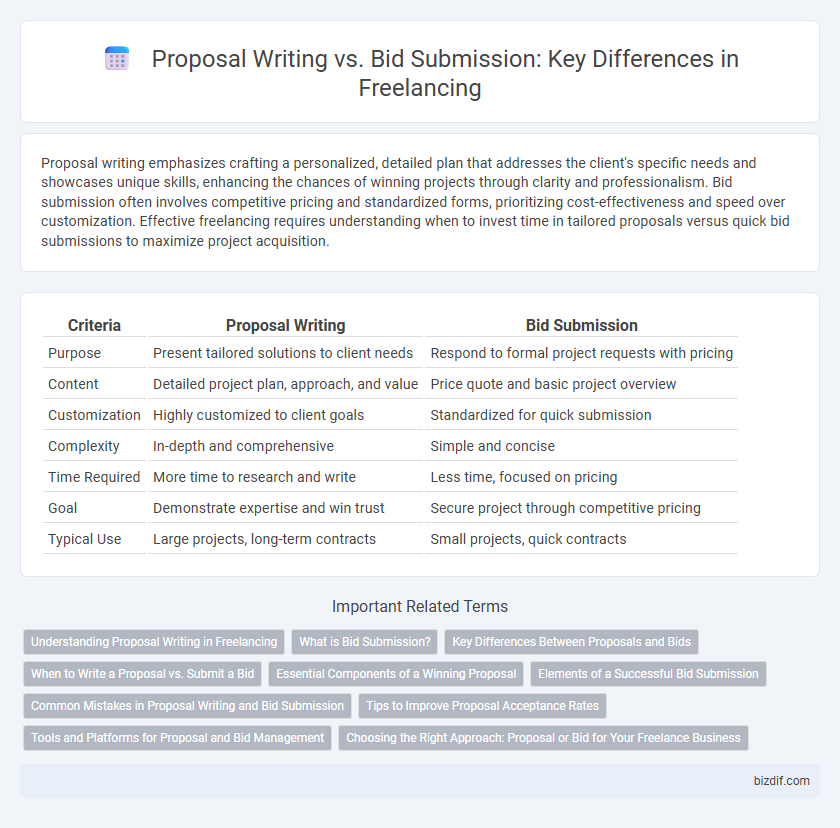Proposal writing emphasizes crafting a personalized, detailed plan that addresses the client's specific needs and showcases unique skills, enhancing the chances of winning projects through clarity and professionalism. Bid submission often involves competitive pricing and standardized forms, prioritizing cost-effectiveness and speed over customization. Effective freelancing requires understanding when to invest time in tailored proposals versus quick bid submissions to maximize project acquisition.
Table of Comparison
| Criteria | Proposal Writing | Bid Submission |
|---|---|---|
| Purpose | Present tailored solutions to client needs | Respond to formal project requests with pricing |
| Content | Detailed project plan, approach, and value | Price quote and basic project overview |
| Customization | Highly customized to client goals | Standardized for quick submission |
| Complexity | In-depth and comprehensive | Simple and concise |
| Time Required | More time to research and write | Less time, focused on pricing |
| Goal | Demonstrate expertise and win trust | Secure project through competitive pricing |
| Typical Use | Large projects, long-term contracts | Small projects, quick contracts |
Understanding Proposal Writing in Freelancing
Proposal writing in freelancing involves crafting a personalized, detailed document that highlights a freelancer's skills, experience, and approach to a client's specific project, aiming to build trust and demonstrate value beyond just pricing. Unlike simple bid submission which often focuses on cost and timelines, a well-written proposal addresses client needs, outlines deliverables, and showcases problem-solving abilities to increase chances of winning contracts. Mastering proposal writing enhances a freelancer's ability to communicate expertise effectively and stand out in competitive marketplaces like Upwork or Freelancer.com.
What is Bid Submission?
Bid submission is the formal process of presenting a competitive offer to complete a project or provide services at a specified price within a given timeframe. It involves responding to a client's requirements with detailed documentation, including cost estimates and timelines, to demonstrate capability and value. Effective bid submission increases the chances of winning contracts by aligning the proposal precisely with the client's needs and evaluation criteria.
Key Differences Between Proposals and Bids
Proposals emphasize a tailored solution and value demonstration, outlining how a freelancer's skills meet the client's specific needs, often including detailed strategies and timelines. Bids focus primarily on price competitiveness and meeting predefined criteria, typically responding to clear project specifications with less emphasis on customization. Understanding these key differences helps freelancers craft either persuasive, client-focused proposals or concise, cost-effective bids to increase their chances of winning projects.
When to Write a Proposal vs. Submit a Bid
Writing a proposal is essential when clients seek detailed project plans, creative solutions, or customized approaches that demonstrate your expertise and understanding of their needs. Submitting a bid is more appropriate in scenarios with clear project specifications, fixed budgets, and competitive pricing where the focus is on cost and timelines. Identifying client expectations and project complexity guides freelancers to choose between crafting a comprehensive proposal or offering a straightforward bid submission.
Essential Components of a Winning Proposal
Effective proposal writing in freelancing requires clear articulation of project understanding, tailored solutions, and a compelling value proposition that aligns with the client's goals. Essential components include a detailed scope of work, realistic timelines, transparent pricing, and evidence of relevant experience or portfolio samples. These elements distinguish a winning proposal from a generic bid submission by demonstrating professionalism, credibility, and a client-focused approach.
Elements of a Successful Bid Submission
A successful bid submission in freelancing includes a clear understanding of the project requirements, a detailed breakdown of costs and timelines, and evidence of relevant expertise or previous work. Emphasizing tailored solutions and measurable outcomes increases client trust and sets the proposal apart from competitors. Precise communication and adherence to submission guidelines further enhance the bid's credibility and chances of selection.
Common Mistakes in Proposal Writing and Bid Submission
Common mistakes in proposal writing include lack of customization to client needs, unclear value propositions, and failure to address project requirements comprehensively. In bid submission, errors often involve missing deadlines, incomplete documentation, and ignoring bid instructions or compliance criteria. Both processes benefit from thorough proofreading, precise language, and alignment with client expectations to increase success rates in freelancing contracts.
Tips to Improve Proposal Acceptance Rates
Crafting a compelling freelance proposal involves clearly outlining your unique skills, customization to the client's needs, and demonstrating past success with relevant examples. When submitting bids, focus on competitive pricing balanced with value, incorporating concise, persuasive language and highlighting how your solution directly addresses the project requirements. Leveraging keywords from the job description and maintaining professional, error-free communication significantly boosts proposal acceptance rates in freelance marketplaces.
Tools and Platforms for Proposal and Bid Management
Proposal writing platforms like Proposify and PandaDoc offer advanced templates, content libraries, and e-signature integration to streamline proposal creation and enhance client engagement. Bid management tools such as BidSync and Procurify provide centralized dashboards, deadline tracking, and collaboration features to efficiently handle multiple bid submissions and ensure compliance with RFP requirements. Leveraging these specialized tools improves accuracy, time management, and the overall success rate of freelancing project acquisition.
Choosing the Right Approach: Proposal or Bid for Your Freelance Business
Choosing the right approach between proposal writing and bid submission is crucial for maximizing success in freelancing. Proposal writing allows for a detailed, customized presentation of skills and solutions tailored to the client's specific needs, enhancing the chance to win complex projects. In contrast, bid submission is often more competitive and price-focused, suitable for straightforward tasks where clients prioritize cost efficiency over detailed strategy.
Proposal writing vs Bid submission Infographic

 bizdif.com
bizdif.com